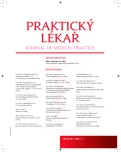Principles of person-centred health care
Authors:
K. Nováková 1; H. Konečná 2; L. Šídlo 3
Authors‘ workplace:
Masarykova Univerzita v Brně
Fakulta sociálních studií
Katedra psychologie
Vedoucí: prof. PhDr. Zbyněk Vybíral, Ph. D.
1; Jihočeská Univerzita v Českých Budějovicích
Zdravotně sociální fakulta
Katedra klinických a preklinických oborů
Vedoucí: prof. MUDr. Miloš Velemínský, CSc., dr. h. c.
2; Univerzita Karlova v Praze
Přírodovědecká fakulta
Katedra demografie a geodemografie
Vedoucí: RNDr. Jiřina Kocourková, Ph. D.
3
Published in:
Prakt. Lék. 2016; 96(1): 14-17
Category:
Of different specialties
Overview
The health care systems in many developed countries are very adversely affected by current demographic trends. As a part of efforts to restructure these systems, a new concept – Person-centred health care (PCHC) – has established itself next to the traditional approaches to health care. Person-centred care is built on principles of respect to the patient as an individual human being; and of equal partnership between the carer and the patient, while patient’s autonomy is being continually encouraged. Some authors and also important health-care related organizations point attention to financial benefits of person-centred health care – compared to the traditional approach, they claim person-centred health care to bring financial austerity to the system. Next to the World Health Organization (WHO), one of the main propagators of person-centred care is The International College of Person-centred Medicine (ICPCM), which published its Declaration on Person-and People-centred Integrated Health Care on its annual international conference in April 2014 in Geneva. We bring a Czech translation of the Declaration as a part of this paper.
Keywords:
person-centred health care – quality in health care – Declaration on Person-and People-centred Integrated Health Care
Sources
1. British Department of Health. NHS 2010-2015: From Good to Great: Preventative, People-centred, Productive, 2009. London: The Stationery Office [on line] [cit. 2014-11-30]. Dostupný z: https://www.gov.uk/government/uploads/system/uploads/attachment_data/file/228885//7775.pdf
2. British Department of Health. Equity and Excellence: Liberating the NHS. London: Stationery Office, 2010 [on line] [cit. 2014-11-24]. Dostupný z: https://www.gov.uk/government/uploads/system/uploads/attachment_data/file/213823/dh_117794.pdf
3. Commonwealth of Australia. National Health and Hospitals Reform Commission. A Healthier Future for All Australians – Final Report of the National Health and Hospitals Reform Commission, 2009. Canberra: National Health and Hospitals Reform Commission [on line] [cit. 2014-11-30]. Dostupný z: http://www.health.gov.au/internet/nhhrc/publishing.nsf/content/1AFDEAF1FB76A1D8CA257600000B5BE2/$File/Final_Report_of_the%20nhhrc_June_2009.pdf
4. Coulter A. The autonomous patient: ending paternalism in medical care. London: Stationery Office 2002.
5. Epstein RM. The science of patient-centred care. J Fam Pract 2000; 49(9): 805–807.
6. Gerteis M, Edgman-Levitan S, Daley D, Delbanco TL (eds.). Through the patient’s eyes: understanding and promoting patient-centred care. San Francisco: Jossey-Bass 1993.
7. International Alliance of Patients’ Organizations. Declaration on Patient-Centred Healthcare. International Alliance of Patients’ Organizations, 2006 [on line] [cit. 2014-11-20]. Dostupný z: http://iapo.org.uk/sites/default/filesfiles/IAPO_declaration_English.pdf.
8. Lutz BJ, Bowers BJ. Patient-centred care: understanding its interpretation and implementation in health care. Sch Inq Nurs Pract 2000; 14(2): 165–183.
9. Picker Institute. Picker principles of patient centred care [on line] [cit. 2014-11-27]. Dostupný z: http://cgp.pickerinstitute.org/?page_id=1319
10. Redman RW. Patient-centred care: an unattainable ideal? Res Theory Nurs Pract 2004; 18(1): 11–14.
11. Robinson JH, Callister LC, Berry JA, Dearing KA. A. Patient-centred care and adherence: definitions and applications to improve outcomes. J Am Acad Nurse Pract 2008; 20(12): 600–607.
12. Rogers A, Kennedy A, Nelson E, Robinson A. Uncovering the limits of patient-centeredness: implementing a self-management trial for chronic illness. Qual Health Res 2005; 15(2): 224–239.
13. Royal College of Physicians. Hospitals on the edge? The time for action: setting higher standards [on line] [cit. 2014-11-26]. Dostupný z: https://www.rcplondon.ac.uk/sites/default/files/documents/hospitals-on-the-edge-report.pdf
14. Shaller D. Patient-centred care: what does it take? The Commonwealth Fund [on line] [cit. 2014-11-20]. Dostupný z: http://www.commonwealthfund.org/usr_doc/Shaller_patientcenteredcarewhatdoesittake_1067.pdf?section=4039
15. The International College of Person-centred Medicine. Geneva Declaration on Person- and People-centred Integrated Health Care for All. The International College of Person-centred Medicine 2014 [on line] [cit. 2014-09-17]. Dostupný z: http://personcenteredmedicine.org/doc/2014_Geneva_Declaration_Released_May_27.pdf
16. The Health Foundation. Priority Topic: Person-centred Care [on line] [cit. 2014-11-30]. Dostupný z: http://www.health.org.uk/areas-of-work/topics/person-centred-care/
17. World Health Organization. People centred care in low- and middle-income countries – meeting report. Geneva: World Health Organization 2010.
18. World Health Organization. People-centred health care: a policy framework. World Health Organization, 2007 [on line] [cit. 2014-11-20]. Dostupný z: http://www.wpro.who.int/health_services/people_at_the_centre_of_care/documents/ENG-PCIPolicyFramework.pdf
19. World Health Organization. The world health report 2008: primary health care: putting people first, 2008 [on line] [cit. 2014-11-30]. Dostupný z: http://www.who.int/whr/2008/chapter3/en/
Labels
General practitioner for children and adolescents General practitioner for adultsArticle was published in
General Practitioner

2016 Issue 1
Most read in this issue
- Consequentialism, deontologism, and medical ethics
- Principles of person-centred health care
- Patient’s stress in hospital, disposition, empathy
- Process of age-related decline of brain function among non-smokers and smokers
